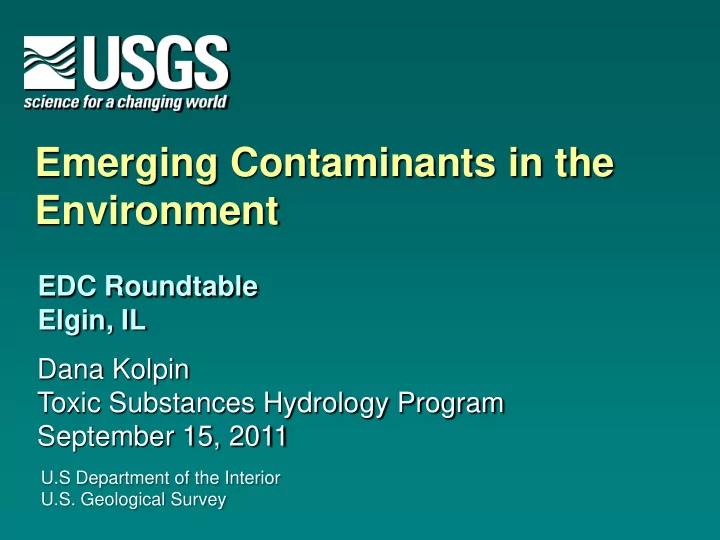

Emerging Contaminants in the Environment EDC Roundtable Elgin, IL Dana Kolpin Toxic Substances Hydrology Program September 15, 2011 U.S Department of the Interior U.S. Geological Survey
EC “umbrella term” • Antibiotics • Human/vet drugs • Hormones • Byproducts • Natural toxins • Fire retardants • Fragrances • Disinfectants • Detergents • Fumigants • Plastics • Plant/animal sterols • PFOS / PFOA • Insecticides/Repellants • Pathogens • Algal toxins/mycotoxins • Resistance genes • Nanomaterials
Better Living Through Chemistry From our homes, farms To our water and workplaces resources x1000s of chemicals are in use daily
Not your father’s caffeine….
Fundamental Research Questions • Are ECs entering our environment? • What are the sources (signatures)? • What happens to them in the environment? • Do they have adverse ecological health effects? • Do unintended exposures pose a human health risk? • How can we minimize their entry to the environment or remove them?
Increasing Research on ECs - Six target journals Number of Publications 100 150 200 250 300 350 50 0 1998 1999 2000 2001 2002 2003 2004 2005 2006 2007 2008 2009 2010 Clofibiric acid in North Sea & Swiss Lakes; Intersex in UK Rivers Pharms in US Streams AB resistance in soils amended with Pig manure slurry Pharms & EDCs in drinking water SSRIs in Fish Tissue ; Estorrogenic mixtures Fish endocrine disruption ELA Canada Glassmeyer, 2010
Are ECs entering our environment? Present in ground water and streams at sub- ppb conc.’s . Present as complex Surface (139) Ground (47) 100 mixtures . 80 Percent Detected 60 Entering via human & 40 animal waste pathways . 20 0 s s e . T e s g b m n E n c a u i i i E e t t r r t e o a e d D f x i f h M b a o . P n i C t u . o n t l e F N A D (Kolpin, et al., 2002; Barnes et al., 2008; Focazio et al., 2008)
Removal in Treatment, NJ Facility Raw Water Finished Water Percent Detection Percent Detection Pharmaceutical/Antibiotic Flame retardant/Plasticizer Levels Generally Reduced by Fragrance Pesticide Treatment with GAC Filters Plant/Animal steroid Detergent metabolite PAHs Others Stackelberg et al., 2004 & 2007
Water “Cycle” Susan Glassmeyer
Uptake into Plant and Animal Tissue • Trimethoprim: in carrots & lettuce; Boxall et al., 2006 • Sulfamethazine: in corn, lettuce, potatoes; Dolliver, et al., 2007 • Triclosan & Trimethoprim: in earthworms; Kinney et al., 2008 • Diclofenac: in mussels; Ericson et al., 2010 • BPA: in fish; Mita et al., 2011 • Antidepressants: in fish; Schultz et al., 2010 • Triclosan: in dolphins; Fair et al., 2009
Ubiquitous Human Exposure Dermal - cosmetics, soaps, other personal care products - exposure to triclocarban after showering (Schebb et al., 2011) Diet - food and drink Inhalation - e.g. household dust Occupational exposure
Evidence for Ecological Effects • Progestin: Disruption of oviduct and ovary development in frogs; Kvarnryd et al., 2011 • Sulfamethoxazole: Affected denitrification rates in bacteria; Underwood et al., 2011 • Triclosan: Inhibited soil microbial respiration; Butler et al., 2010 • Trenblone: Irreversible fish masculinization; Morthorst et al., 2010 • Antidepressants: Impaired predator avoidance behavior larval fathead minnow; McGee et al. 2009.
An Approach to Linking Chemical Exposure and Endocrine Disruption Reference Treatment with University of Colorado On Site - stream waters with controlled photo-period and Vajda et al., 2011 water temp.
Human Health Effects? • Less is known related to human health effects - difficulty in conducting epidemiological studies • Concern of fetal exposure - classic example: diethystilbestrol • Animals as sentinels • View that adverse effects from pharms in drinking water are not expected (Bruce et al., 2010; WHO, 2011)
New Questions Raised • Epigenetics - e.g. chemical modification of DNA (Choudhuri, 2010) - fetal basis of adult disease (early exposure late effects) • Transgenerational transmission - chemicals exposed to now could impact future generations Novel lab and field approaches needed to fully understand the ultimate effects from exposures to complex mixtures
Questions? toxics.usgs.gov/regional/emc
Recommend
More recommend